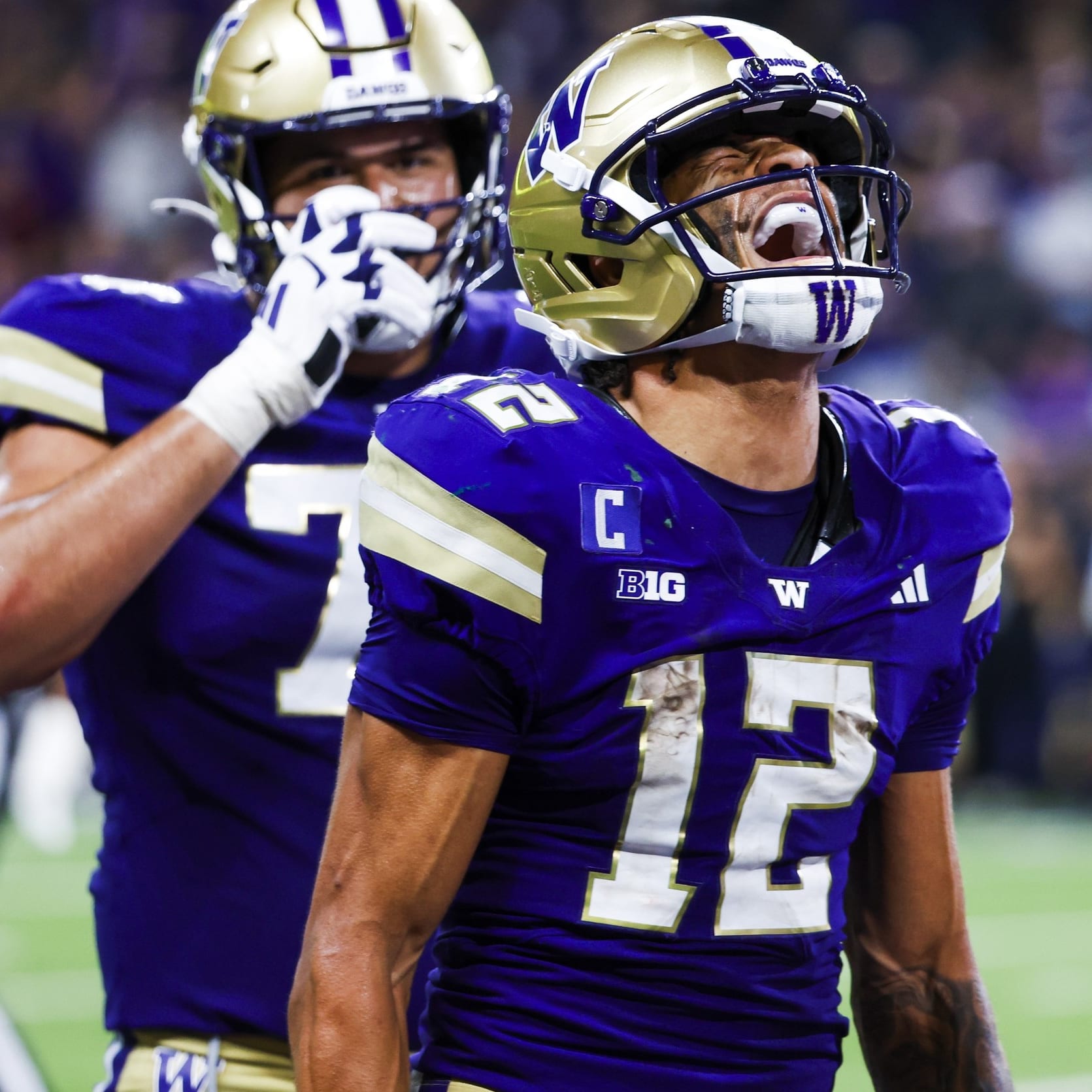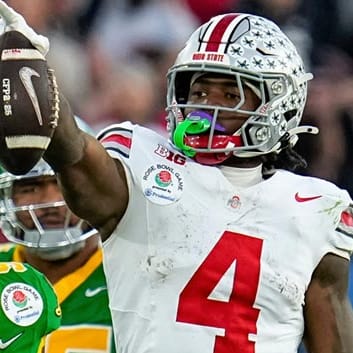College Fantasy Football is like fantasy football on steroids because there is just so much offense and so many players to pick from. It can be overwhelming at first for someone used to just NFL, but once you get a taste of it, you won't be disappointed. Understanding the differences between CFB and NFL is the most important part of cashing in your contests.
Here are some of the top things you need to know and tools you can use to start winning on FanDuel.
Projecting Team Totals
Look at the Vegas lines each week and start to find the teams who are projected to score the most points.
Here are this week's projected team totals (Thursday slate):
Arizona – 41.5
Oklahoma State – 38.5
TCU – 35.5
South Carolina – 33.5
Vanderbilt – 32.5
Ohio – 32
Central Florida – 31.5
Western Kentucky – 31.5
North Carolina – 30.5
Duke – 28
You get these numbers by looking at a game. Let's go with Vanderbilt/Western Kentucky. The total posted in the game is now 64 with Vanderbilt -1. Divide the total by two (32) and cut the spread in half (0.5), then add both numbers to get Vanderbilt's projected total of 32.5. Then subtract 32.5 from the total of 64 points to get Western Kentucky's total of 31.5, making 32.5-31.5 the projected total for the game. I usually look for teams with a projected total of at least 28 and a line of -21 or less. The one exception is I'm not afraid to take smaller schools that are favorites of at least 28.
Smaller schools do not pull their starters because they need to score as many points as possible to keep a higher ranking. Bigger schools are more apt to pull their starters when they have a huge lead. Bigger schools make more money and thus have more invested in the health of their starters, and smaller schools have reason to play starters longer because their schedules are too weak to earn reliable top-25 consideration without an eye-popping margin of victory.
Offense/Defense Ranks (Run/Pass)
Now that we have our targeted teams based on projected point totals, let's look at the teams that have the biggest edge for offense/defense based on yardage ranks. Early in the season I use Phil Steele's team projections. You want to seek out teams that have a significant edge in the passing or running game along with a higher percentage of the offense coming from one of the two sides. It's all about exploiting a matchup.
Passing (Quarterback/Wide Receiver/Tight End targets)
Western Kentucky – 349 yards
TCU – 340 yards
Oklahoma State – 328 yards
North Carolina – 313 yards
Arizona – 279 yards
Idaho – 272 yards
Rushing (Running Back/Rushing Quarterback Targets)
TCU – 225 yards
North Carolina – 209 yards
Michigan – 199 yards
Ohio – 190 yards
Arizona – 190 yards
Percent of Run vs. Pass
I want my players on teams with a projected total of at least 28 points, and I want them to be a highly used part of consistently high-scoring passing/rushing/receiving games from those teams. It's obviously ideal if you can put together a team of players whose team touchdown percentages line up with a projected score that implies a probable touchdown.
Quarterback is King
You only start one quarterback, so much like starting pitching in baseball you need to hit to win. You want to look for ones in the highest projected scoring games, but you also want to target an elite passer (400 yards per game potential) or a quarterback who runs a lot. Do not skimp on spending at the quarterback position, as they are the players who score the most fantasy points on a week-to-week basis.
The one exception is when you find a starting quarterback at almost minimum salary with a good matchup. That is the case this week with Duke's Thomas Sirk, who is only $5,100. While there is risk associated with him, he is a running quarterback which boosts his value and will make up for the lack of passing yards.
Find Value at Running Back
You can usually find value at the running back position due to injury, suspension or matchup. Almost every week there are solid running back plays in the $4,000-$6,500 range. This article last year had Nick Chubb at $4,600 and T.J. Yeldon at $4,400. With a short slate on Thursday it is a bit more challenging. Some examples this week are: Roderick Williams ($6,000) who takes over the starting running back spot in Minnesota from David Cobb, while Martez Walker is listed as the starting running back for Central Michigan and is only $4,500.
Last Years' WR2 Can Be This Years' WR1
The great thing about college fantasy football is that players graduate, so when Nelson Agholor goes to the NFL, a player like JuJu Smith automatically gets thrust into a great spot. The pricing is usually based on last year, so you can find great value early on with those wide receivers.
Pair your Wide Receivers and Quarterbacks
There is strong data that shows how much a quarterback's success correlates with the wide receiver, so you want to try and find at least one or two to pair up. If you have a running quarterback, then look elsewhere. For example, you would definitely want to find a WKU wide receiver to pair with Brandon Doughty this week.
Skimp on Tight End
Because so many college football teams run the spread offense and three wide receiver sets, the tight tight end position is a lost art. There are some elite tight ends, but it just does not make sense to pay up unless it is a short slate like this Thursday. Look for someone who gets a few receptions each week in a high-scoring game so that a touchdown is a high probability. Jerell Adams is a potential bargain play this week because of the expected high score between South Carolina and North Carolina. Also, Steve Spurrier came out and said he will be a bigger part of the offense in 2015.
Rotowire has a vast amount of content that you can use for college football:
Player News
This is where you need to look for all your injury and starting players news. Critical when looking for value plays.
Depth Charts
Look for who might be the next player up if a starter is ruled out that week.
Injury Updates
On the right-hand side, you can see all the players listed who are "out", "questionable", "doubtful", "probable" or "suspended".
Waiver Wire Watch
Check out this piece to see who might be your value plays of the week.
CFB Barometer
Who is up, who is down for the week.
Rotowire College Fantasy Football Podcast
Mario Puig and James Anderson provide extensive weekly coverage of college football for season-long fantasy and DFS players.
Weekly Rankings
Each week, Mario Puig gives you his weekly positional rankings
College Football Lineup Optimizer
The lineup optimizer is a great tool to build a lineup and see which players are the best values along with top projected players. You can select from any teams on the right side depending on the game set, etc. If you want to remove teams from low scoring games you can. It's a useful tool to get a feel for how a lineup should be constructed. Note: we do not offer "projections" for college football, just a ranking. You can also add in players to lock them in for the optimizer. So let's say you like Brandon Doughty as your quarterback, just click on the lock icon to the left of his name and hit "Refresh your Optimal Lineup Now."
FanDuel College Football Lineup Optimizer Week 1
Sample Lineup (Thursday Slate)

Roster Format: QB, RB, RB, WR, WR, WR, TE
Scoring Format:
Rushing yard = 0.1points
Rushing TD = 6
Passing yard = 0.04
Passing TD = 4
Interception = -1
Receiving yard = 0.1
Receiving TD = 6
Reception = 0.5
Fumble = -2
2-point conversion = 2
One of the biggest reasons you should be playing college fantasy football on FanDuel is the $500,000 Playboy College Football Championship on November 21. First prize is $100,000 and there are 70 entrants. The qualifiers in Week 1 are $25 and $200.









































